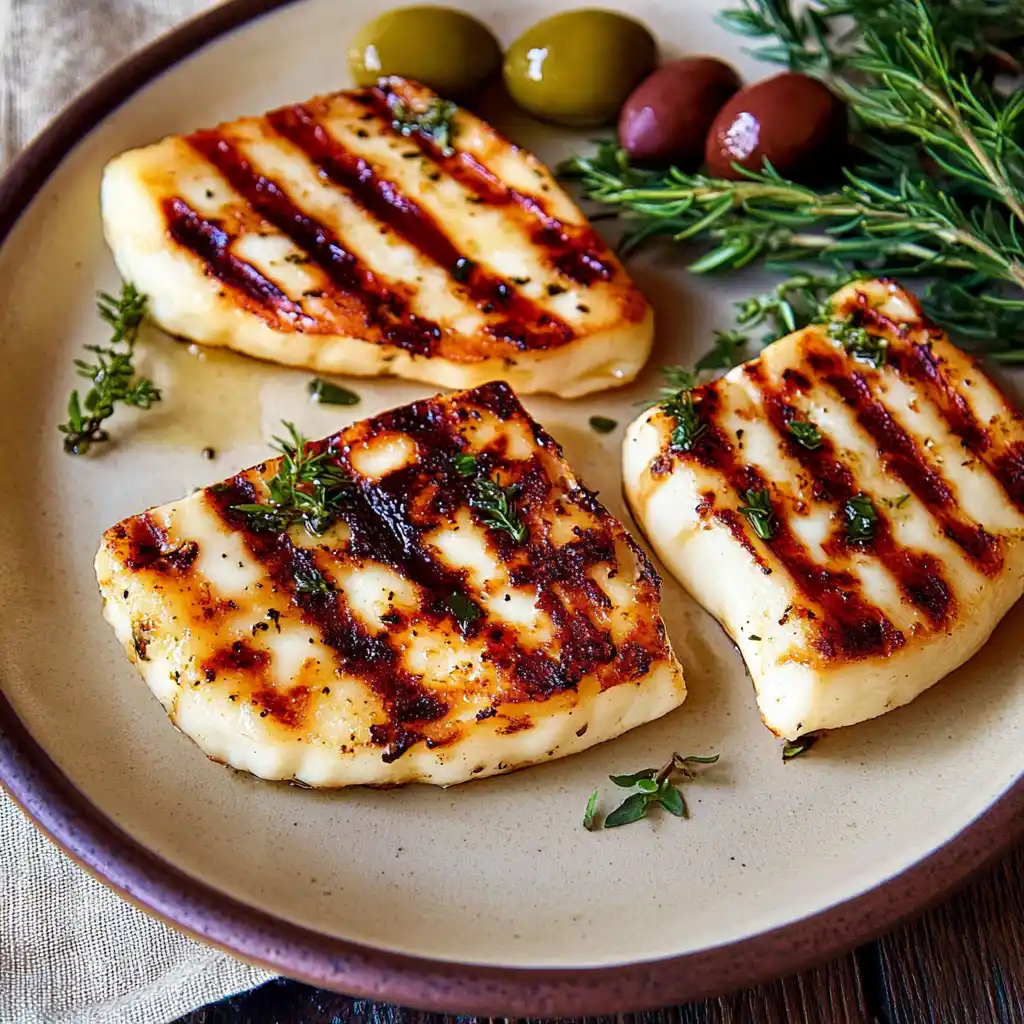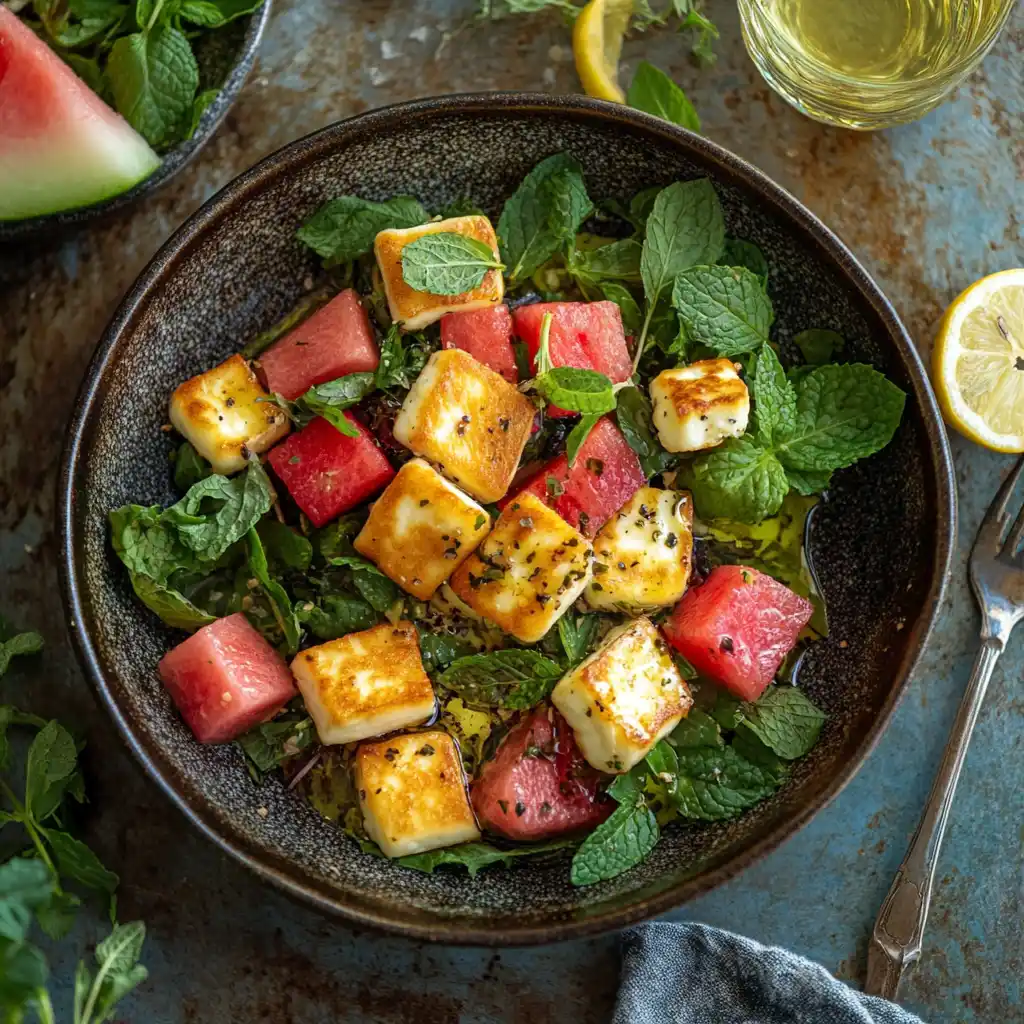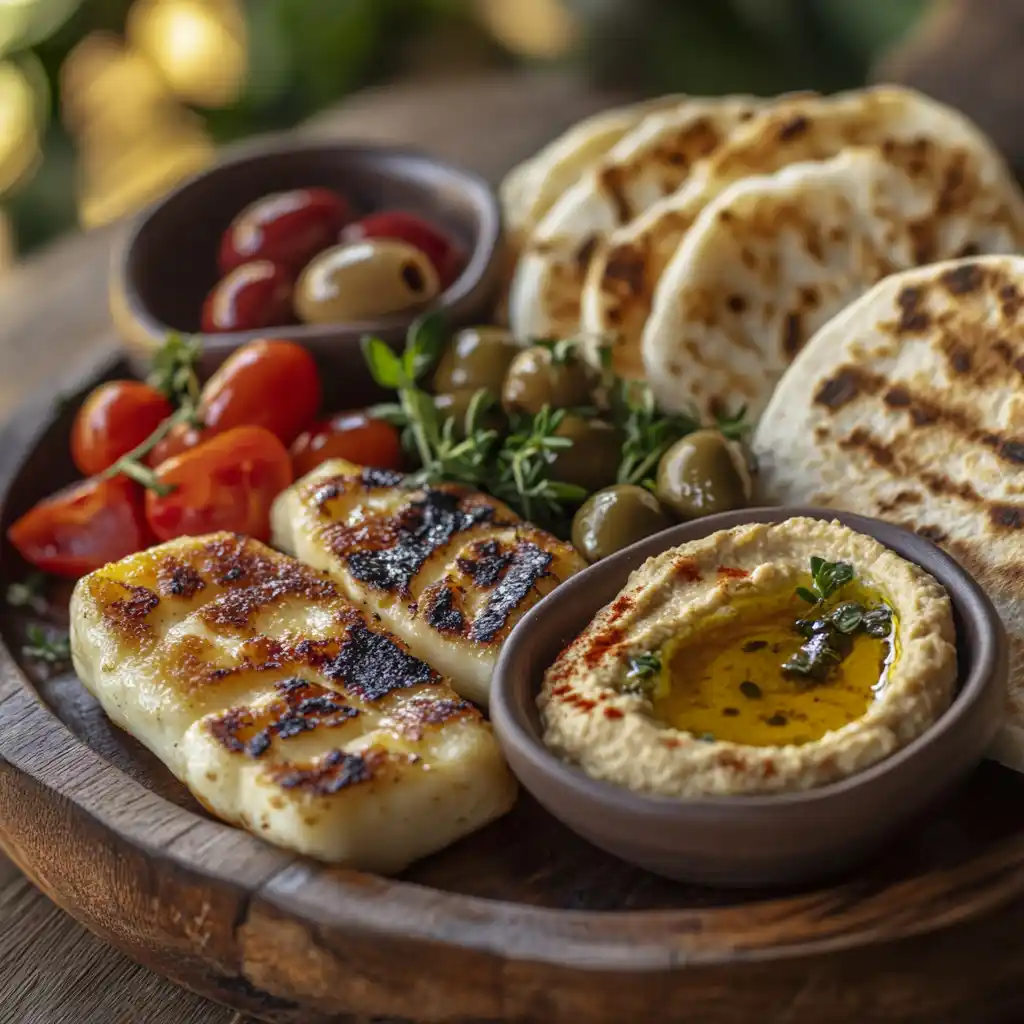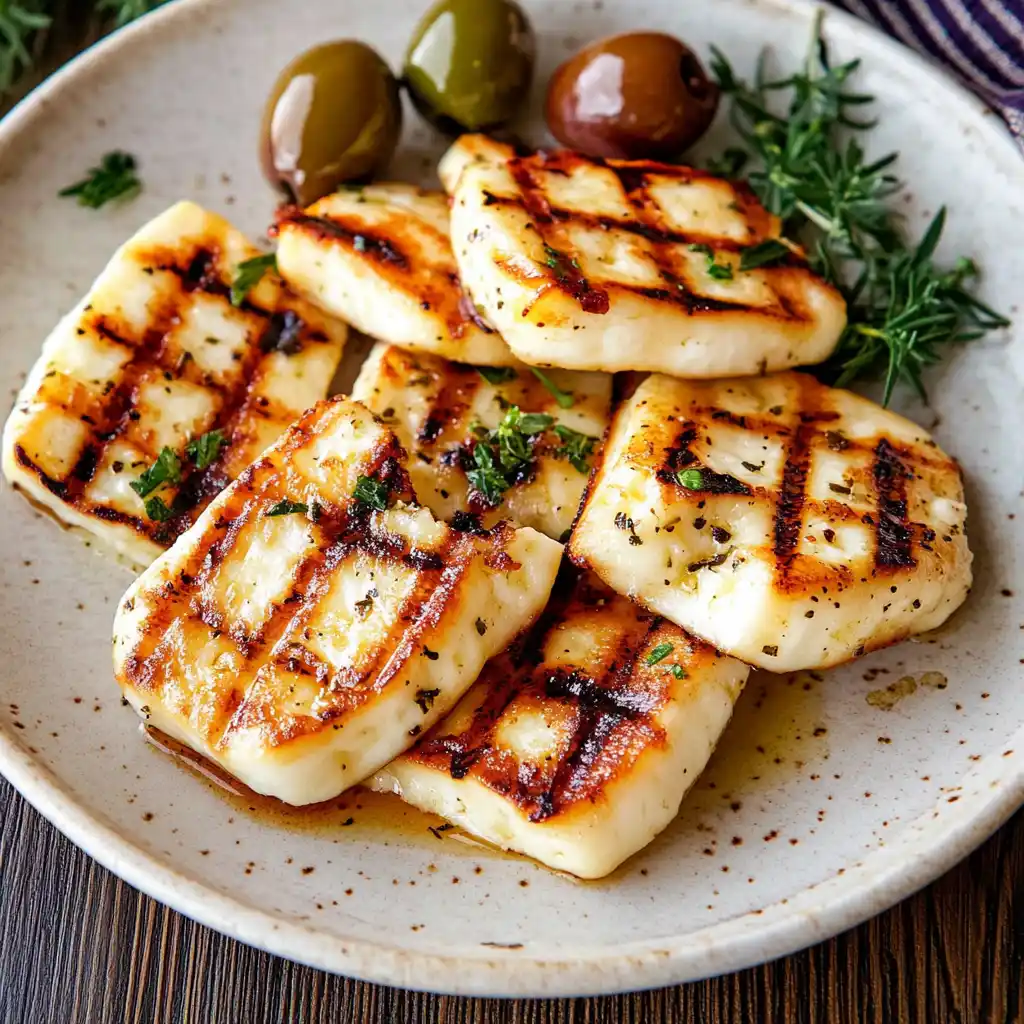Looking for the ultimate Halloumi Cheese Recipe that brings authentic Mediterranean flavors right to your table? You’re in the right place. Halloumi is no ordinary cheese—it’s a semi-hard, brined cheese that holds its shape when grilled or fried, delivering a golden crust and a chewy, salty bite that’s hard to resist. Whether you’re planning a family cookout, a cozy dinner, or a healthy lunch, having a go-to Halloumi Cheese Recipe opens the door to countless delicious creations.
In this comprehensive guide, we’ll cover everything from how to make a traditional Halloumi Cheese Recipe at home to the best ways to cook it perfectly every time. You’ll discover creative recipes featuring Halloumi cheese, including salads, wraps, and Mediterranean dishes that will elevate your meals. We’ll also explore what you can eat with Halloumi cheese, its health benefits, and how to avoid common cooking mistakes that can ruin its texture.
Curious about how to pan-fry or grill Halloumi cheese? Or maybe you’re wondering if Halloumi cheese is healthy? We’ve got you covered. Plus, we’ll answer the most asked questions about Halloumi Cheese Recipe and help you get inspired with delicious pairing ideas.
Table of Contents
What is Halloumi Cheese and Why is it Special?
The Origins and History of Halloumi Cheese
Halloumi cheese is more than just a delicious ingredient—it’s a culinary symbol of Mediterranean tradition, particularly from the island of Cyprus. This Halloumi Cheese Recipe dates back to the Byzantine era, where communities prized it for its ability to be stored without refrigeration, making it a valuable staple for shepherds and farmers.
Traditionally, Halloumi is made using a blend of goat’s and sheep’s milk, though cow’s milk is sometimes added today for a milder taste. The name “Halloumi” itself is believed to come from the Greek word “almi,” meaning salty, which perfectly describes its rich, briny flavor. The process of curdling the milk, poaching the cheese, and then salting it heavily makes Halloumi both durable and flavorful—qualities that have helped it earn a cult following globally.
What sets Halloumi Cheese Recipe apart is its ability to bridge cultures and cooking styles. Whether in Cyprus, Greece, the Middle East, or now popular cafes in the U.S. and UK, this cheese has become a trendy ingredient for its satisfying texture and unique taste.
Unique Texture and Taste That Makes Halloumi Stand Out
If you’ve never tried a Halloumi Cheese Recipe, the first bite will surprise you. Unlike typical cheeses that melt into gooey pools, Halloumi holds its shape when cooked. Thanks to its high melting point, it develops a crispy golden crust on the outside while remaining soft and chewy inside.
Its briny and slightly tangy flavor profile makes it ideal for both savory and sweet dishes. This chewy cheese delivers an unexpected contrast of textures that delights food lovers everywhere. It pairs wonderfully with citrus, herbs, and fresh vegetables, but can also be enjoyed as a stand-alone appetizer or grilled entrée.
Whether you’re pan-frying, grilling, or baking, Halloumi Cheese Recipe provides endless opportunities to elevate your dishes with minimal effort. No wonder chefs and home cooks alike consider it a must-have for creative and satisfying meals.
How to Make Halloumi Cheese at Home: Authentic Recipe
Essential Ingredients and Tools for Homemade Halloumi Cheese Recipe
Making your own Halloumi Cheese Recipe at home might sound intimidating, but it’s surprisingly straightforward with the right ingredients and tools. By using fresh milk and a few simple steps, you can create authentic Halloumi cheese that rivals any store-bought version.
Ingredients:
| Ingredient | Quantity |
|---|---|
| Fresh goat’s or sheep’s milk | 4 liters (or cow’s milk as a substitute) |
| Rennet tablets or liquid | As per package instructions |
| Cheese salt or sea salt | To taste |
| Optional: Mint leaves | For traditional garnish |
Tools Needed:
- Cheese thermometer
- Large stainless-steel pot
- Cheesecloth
- Cheese mold or strainer
- Long knife for cutting curds
- Slotted spoon
Having these tools on hand ensures your Halloumi Cheese Recipe comes together smoothly, resulting in a perfect texture and authentic taste.

Step-by-Step Process for Making Halloumi Cheese at Home
1. Heat and Curdle the Milk
Pour the milk into a large pot and gently heat it to 90°F (32°C), stirring occasionally. Once it reaches the desired temperature, add the rennet as instructed. Let the mixture sit undisturbed for about 45 minutes, until it forms a firm curd.
2. Cut and Cook the Curds
Using a long knife, carefully cut the curds into 1-inch cubes. Slowly heat the curds to 105°F (40°C), stirring gently to help the whey separate from the curds. Allow the curds to settle for 15 minutes.
3. Drain and Press the Cheese
Transfer the curds into a cheesecloth-lined mold or strainer, allowing the whey to drain completely. Apply light pressure to shape the cheese and let it rest for several hours.
4. Poach and Salt
Heat the reserved whey to about 195°F (90°C). Poach the pressed cheese for 30-40 minutes until it floats. Remove and sprinkle with salt on all sides. Optionally, fold in mint leaves for added flavor.
5. Store and Enjoy
Once cooled, your homemade Halloumi Cheese Recipe is ready to be enjoyed immediately or stored in brine for longer shelf life. Its unique texture and salty tang will shine whether you fry, grill, or add it to your favorite dishes.
Best Ways to Cook Halloumi Cheese for Perfect Results
How to Pan-Fry Halloumi Cheese to Get That Golden Crust
One of the most popular ways to enjoy a Halloumi Cheese Recipe is by pan-frying it. This method gives the cheese its signature golden crust while preserving its soft, chewy center. Plus, it takes just minutes, making it an ideal choice for quick meals or appetizers.
Steps for Pan-Frying Halloumi:
- Slice the Halloumi into ½-inch thick pieces.
- Heat a non-stick skillet or cast-iron pan over medium-high heat.
- Place the slices directly onto the dry pan—no oil needed as Halloumi releases its own moisture.
- Cook for 2-3 minutes on each side until a golden, crispy crust forms.
The result? A delicious, squeaky cheese with caramelized edges that pairs perfectly with salads, sandwiches, or served simply with a drizzle of lemon juice.
Pro Tip: Want extra flavor? Sprinkle smoked paprika or za’atar on your Halloumi Cheese Recipe just before serving.
Grilling Halloumi Cheese for Smoky Flavor
For those who prefer an outdoor vibe, grilling is another excellent method to prepare a Halloumi Cheese Recipe. The grill marks not only add visual appeal but also deepen the cheese’s savory notes with a smoky finish.
Steps for Grilling Halloumi:
- Preheat your grill or grill pan to medium heat.
- Brush the Halloumi slices lightly with olive oil to prevent sticking.
- Place the slices directly on the grill grates or pan.
- Grill each side for about 3-4 minutes, or until beautiful charred lines appear.
Grilled Halloumi can stand alone as a main dish or become the star ingredient in wraps, veggie skewers, or hearty grain bowls.
These methods are not only quick and easy but also ensure that every Halloumi Cheese Recipe you try at home turns out deliciously golden, crispy, and flavorful.
Delicious Halloumi Cheese Recipe Ideas and Meal Inspirations
Fresh Salads with Halloumi Cheese Recipe for Summer Days
When it comes to vibrant summer dishes, incorporating a Halloumi Cheese Recipe into fresh salads is a game changer. The salty, chewy texture of Halloumi perfectly contrasts with crisp vegetables and zesty dressings, turning a simple salad into a satisfying meal.
Must-Try Halloumi Salad Ideas:
- Watermelon and Halloumi Salad: Combine grilled Halloumi with sweet watermelon, fresh mint, and a squeeze of lime for a refreshing twist.
- Mediterranean Halloumi Salad: Toss baby spinach, cherry tomatoes, cucumbers, olives, and pan-fried Halloumi. Finish with a lemon-oregano vinaigrette.
- Roasted Veggie & Halloumi Warm Salad: Mix roasted peppers, zucchini, and eggplant with grilled Halloumi for a hearty and colorful bowl.
Not only do these salads make use of your Halloumi Cheese Recipe, but they also bring out the best of seasonal produce and bold flavors.
Halloumi Cheese Sandwich and Wrap Recipes
Looking for a savory twist to your lunch routine? The Halloumi Cheese Recipe shines in sandwiches and wraps, offering a meaty texture without the meat. It creates an indulgent yet wholesome meal option for vegetarians and cheese lovers alike.
Creative Sandwich and Wrap Ideas:
- Halloumi and Avocado Wrap: Layer pan-fried Halloumi with creamy avocado, fresh greens, and a drizzle of tahini dressing inside a warm tortilla.
- Grilled Halloumi Baguette: Stack crispy Halloumi, roasted red peppers, arugula, and basil pesto on a crusty baguette for a Mediterranean street food vibe.
- Halloumi Breakfast Sandwich: Top an English muffin with fried Halloumi, a fried egg, and spicy sriracha mayo for a protein-packed start to your day.
These ideas prove that Halloumi Cheese Recipe isn’t limited to side dishes—it can take center stage in sandwiches, wraps, and hearty meals that satisfy even the biggest appetites.

Don’t miss our high-protein egg salad sandwich that makes a nutritious partner for your Halloumi Cheese Recipe wraps, offering a protein-packed twist for lunch menus.
What Can You Eat with Halloumi Cheese? Pairings & Serving Ideas
Classic Mediterranean Pairings for Halloumi Cheese
One of the beauties of any Halloumi Cheese Recipe is its adaptability to classic Mediterranean flavors. The cheese’s salty richness pairs beautifully with fresh, herbaceous, and tangy components commonly found in Mediterranean cuisine.
Mediterranean Pairing Ideas:
- Grilled Vegetables: Halloumi loves company like roasted bell peppers, zucchini, and eggplant drizzled with olive oil and lemon.
- Couscous or Bulgur Wheat: Serve your grilled or fried Halloumi on a bed of fluffy grains, finished with chopped herbs like parsley and mint.
- Hummus and Pita Bread: Make a simple yet satisfying platter with warm pita, creamy hummus, olives, and slices of crispy Halloumi cheese.
By combining your Halloumi Cheese Recipe with these Mediterranean staples, you can create elegant yet simple dishes perfect for any gathering or family meal.
Creative Sides and Dips to Serve with Halloumi Cheese
Want to break away from the traditional? These inventive sides and dips can elevate your Halloumi Cheese Recipe to new heights, offering exciting textures and bold flavors.
Creative Pairing Ideas:
- Sweet Chili or Honey Drizzle: The saltiness of Halloumi contrasts wonderfully with sweet, sticky sauces like chili jam or honey.
- Fruit Compotes and Chutneys: Pair fried Halloumi with fig chutney or apricot compote for a sweet-savory combination.
- Herb Yogurt Dip: Blend yogurt with dill, garlic, and lemon zest as a refreshing dip that cuts through Halloumi’s richness.
These creative sides add color, texture, and variety, ensuring your Halloumi Cheese Recipe never feels repetitive. Whether you’re serving it at brunch, lunch, or dinner, these additions make Halloumi the star of the plate.

Looking for inspiration? Try this comforting broccoli cheese casserole alongside your Halloumi Cheese Recipe for a satisfying family-style meal.
Is Halloumi Cheese Healthy? Nutrition, Calories, and Benefits
Nutritional Profile of Halloumi Cheese
When preparing any Halloumi Cheese Recipe, it’s helpful to understand its nutritional content, especially if you’re mindful of calories or following a balanced diet. Halloumi cheese is known for its high protein and fat content, which makes it both filling and flavorful.
| Nutritional Component | Amount per 100g |
|---|---|
| Calories | 320 kcal |
| Protein | 22g |
| Fat | 25g |
| Carbohydrates | 1.8g |
| Calcium | 700mg |
| Sodium | 850mg |
Because of its brining process, Halloumi has a relatively high sodium level, which enhances its savory punch but also requires moderation if you’re watching your salt intake.
Health Benefits and Things to Consider When Eating Halloumi
Despite its richness, incorporating Halloumi Cheese Recipe into your diet can have some surprising benefits. Halloumi provides a great source of high-quality protein, making it a satisfying addition to vegetarian dishes and meals lacking meat. It’s also packed with calcium, supporting healthy bones and teeth.
Benefits of Halloumi Cheese:
- Protein Powerhouse: Great for muscle repair and satiety.
- Calcium Boost: Essential for bone strength.
- Versatile Meat Alternative: Perfect for plant-forward meals.
Things to Consider:
- High in Saturated Fat: Like many cheeses, Halloumi contains saturated fat, which should be balanced within a healthy diet.
- Salt Content: Due to its brining, Halloumi has higher sodium levels, which can impact those with hypertension or heart concerns.
To enjoy a Halloumi Cheese Recipe in a health-conscious way, pair it with plenty of vegetables, whole grains, and lighter sides that balance its richness and saltiness.
Halloumi Cheese Variations and International Twists
Halloumi-Inspired Cheeses and Vegan Alternatives
While nothing quite matches the original Halloumi Cheese Recipe, there are several alternatives for those seeking different dietary choices or flavors. Around the world, cheesemakers have created similar cheeses inspired by Halloumi’s famous texture and grilling capabilities.
Popular Variations:
- Paneer: An Indian cheese that doesn’t melt when cooked, making it a good stand-in for some Halloumi dishes.
- Queso Para Freir: Popular in Latin America, this cheese can be fried and offers a texture close to Halloumi.
- Vegan Halloumi Alternatives: Brands now produce plant-based versions using soy or coconut oil, offering a dairy-free option that mimics Halloumi’s chewy texture.
These variations allow you to get creative with your Halloumi Cheese Recipe, adapting it for different dietary needs or exploring new global twists.
International Dishes Featuring Halloumi Cheese
Halloumi has become a global star, appearing in dishes far beyond its Cypriot origins. From British brunch menus to Australian BBQs, the versatility of a good Halloumi Cheese Recipe makes it a favorite in diverse cuisines.
Global Halloumi-Inspired Dishes:
- Halloumi Tacos (Mexico): Swap meat for grilled Halloumi topped with pico de gallo and avocado.
- Halloumi Burger (USA): Use a thick slice of grilled Halloumi as a meatless burger patty, topped with lettuce, tomato, and aioli.
- Halloumi & Couscous Bowls (Middle East): Layer fried Halloumi over spiced couscous, roasted veggies, and tahini drizzle.
These international recipes highlight how the Halloumi Cheese Recipe can be a canvas for creativity, giving dishes a salty, satisfying bite that works across cultures and meals.
Common Mistakes to Avoid When Cooking Halloumi Cheese
Why Does Halloumi Become Rubbery? How to Prevent It
A common frustration with cooking Halloumi is that it can turn rubbery or overly chewy if not handled correctly. Whether you’re following a simple Halloumi Cheese Recipe or an elaborate dish, technique matters.
Causes of Rubbery Halloumi:
- Overcooking: Leaving Halloumi on the pan or grill for too long can make it tough.
- Using Too Much Oil: Since Halloumi releases moisture, adding excessive oil can lead to a greasy texture rather than a golden crust.
- Incorrect Thickness: Slices that are too thin can dry out and become rubbery quickly.
Tips to Avoid Rubberiness:
- Slice Halloumi into even ½-inch pieces for the ideal balance of crispy outside and soft inside.
- Cook over medium-high heat and monitor closely, turning once golden.
- Avoid adding oil unless using a sticky grill pan; Halloumi has enough fat to cook beautifully on its own.
By following these tips, your Halloumi Cheese Recipe will deliver the perfect texture every time—crispy on the outside, juicy and tender inside.
Overcoming Common Cooking Errors for Halloumi Cheese
Even seasoned cooks sometimes trip up when handling Halloumi. Avoiding these common mistakes can make a significant difference in your Halloumi Cheese Recipe.
Mistakes to Watch Out For:
- Skipping the Pat Dry Step: Always pat Halloumi dry before cooking to prevent steaming rather than frying.
- Using Low Heat: Cooking at too low a temperature prevents the signature crust from forming.
- Overcrowding the Pan: This leads to uneven cooking and a soggy texture.
Perfecting your Halloumi Cheese Recipe is all about attention to detail. With these simple adjustments, you’ll elevate your Halloumi dishes from good to truly exceptional.
FAQs About Halloumi Cheese Recipe
What can you eat halloumi cheese with?
What is the best way to cook halloumi?
What can I make with halloumi?
Is halloumi cheese healthy?
Conclusion
Mastering the Halloumi Cheese Recipe opens up a world of delicious, versatile meals that delight cheese lovers everywhere. From its ancient Mediterranean origins to its modern-day popularity across global cuisines, Halloumi is a cheese that brings excitement and variety to your kitchen. By learning how to make it at home, cook it perfectly, and pair it creatively, you can elevate everyday dishes into gourmet experiences.
Whether you’re preparing a summer salad, sizzling it on the grill, or creating bold international twists, the possibilities are endless with a Halloumi Cheese Recipe. Just remember to balance it with fresh, vibrant sides to enjoy both its flavor and health benefits.
After enjoying your savory Halloumi Cheese Recipe, why not indulge in a sweet finish with this creamy ricotta cheesecake?

